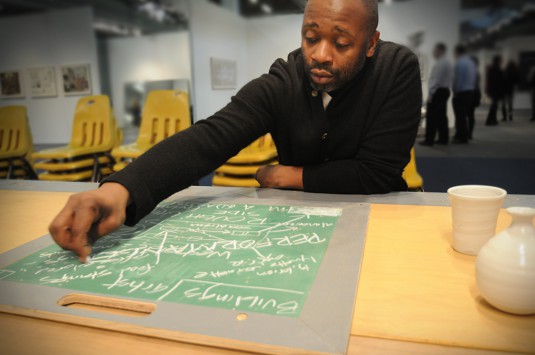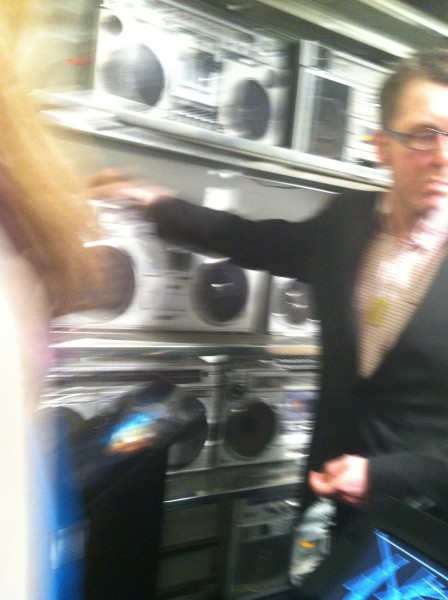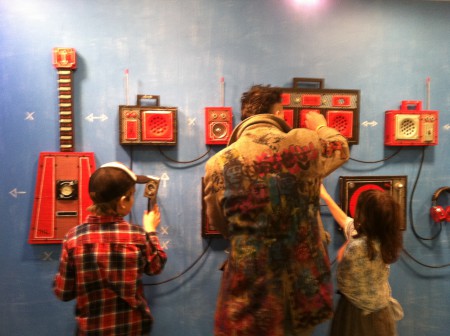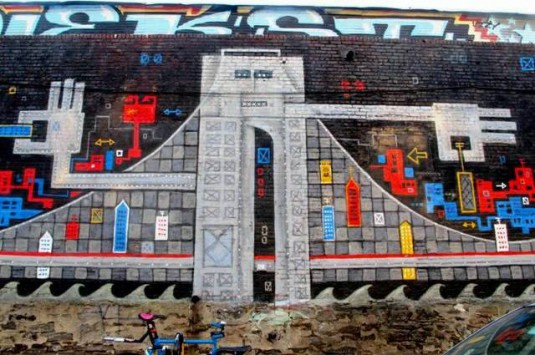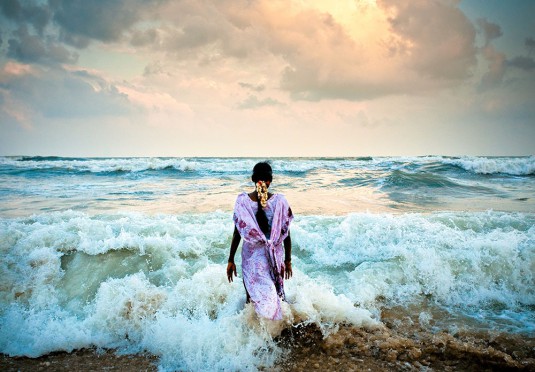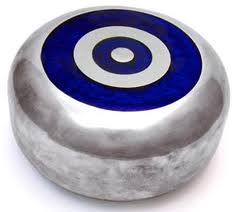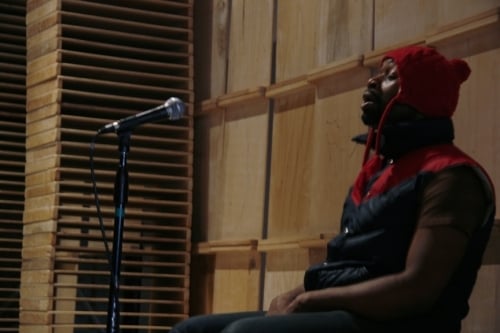
March 26, 2012
99th Edition of the Armory Show
From Susan B. Komen to Kony, public discourse is the art “Happening,” taking to the streets and Twitter to affect global change and re-invention. Fortified with OWS, riots, performances, street art and viral social media campaigns, our public policy as well as our public lives are shaped by this expanding discourse. Art for social exchange […]
From Susan B. Komen to Kony, public discourse is the art “Happening,” taking to the streets and Twitter to affect global change and re-invention. Fortified with OWS, riots, performances, street art and viral social media campaigns, our public policy as well as our public lives are shaped by this expanding discourse. Art for social exchange and change is vital to this discourse. With spring madness upon us, I continue my interest in how art can be shared by the community as part of the envisioning and evolution of the species. Too much to ask for?
Art that lights a sudden, crackling fire in the haze, skews one’s head so it hurts a bit and awakens and puzzles unexpectedly in the night. Yes?
It’s been 99 years since the fiery and radical 1913 debut of the Armory Show in New York, where modern masters such as Marcel Duchamp’s’ nude descended a staircase and blasted open Victorian attitudes and created dialogue. Honoring that legacy in name, New York’s Armory fine art trade show traditionally opens the spring season. Thinking ahead to the 100th anniversary next year of that seminal show, I visited the fair, the satellite shows around it, and three noteworthy art events of the season considering them my Petri dish, my crystal ball to see just where the art world is expressing and integrating community…can an Art Fair still rankle jaded New Yorkers’ perspective? The answer is Yes.
Signs of what I like to call “art off the cave walls” were present. This goes beyond the hallowed old model “art” made solely by artists in studios, or even art manufacturing teams in warehouses overseen by commodity traders such as Koons or Hirsch’s and sold to be quietly tucked away in a collector’s home or museum storage for investment. Instead there is art by modern-day shamans, for the intended purpose of public ritual experience and transcendence. Today, millions of the general public are directly engaged with “art,” scrapbooking away on Pinterest, or sharing Angelina Jolie memes on Facebook, fed with a steady fast food image diet streaming from YouTube and flat screens. Clearly 15 minutes of fame via 2D image bombardment alone does not change the world, albeit engagement with “art” has become a new kind of populist tool.
That’s the beauty of temporal art, from 15-minute fame viral art memes online to environment friendly performance art, anyone, not just the “1%,” can have direct experience of “being there,” in the midst of history as an art-maker and documenter. If one says there is a “there” there, there is. Art establishment stalwarts, Christies’ storage experts at their Armory booth space, spoke cheerfully on the “storage of” temporal art, wherein for valuing and the posterity, only the paperwork, the documentation, must be preserved. However, the truth is that paper’s own temporality cannot trump the art, craft, and validity of online documentation, now sourced from multiple media generators themselves, aka the general public, through Twitter and cell phone cameras. This determines newer distinguishing value factors and the question of art “ownership” now begins to be redefined—a very different model of society. The future we are building is here and it’s coming.
So how did the art world itself bring this change on? Did they build it this spring, and did the people come?
The “There” at an Art Fair
Ken Johnson of The New York Times has called the Armory Show a “maze of art shops” and this year the fair, in order to further personally engage its 60,000 visitors, actually cited a focus on “urban restoration,” via both the commissioned artist for the whole show, urban architect, performance artist, and art-world golden boy of the moment, Theaster Gates, to a re-design of the show floor by architects, Jane Stageberg, AIA, LEED AP of Bade Stageberg Cox.
The architects approached the fair from an urban design perspective, easing traffic flow, visually defining public space with bright colors, enlarging the VIP lounges and creating champagne lounges. One architect said, “The redesign for the Armory Show exceeded our expectations. The bold visual identity of the lounges seemed to effectively create necessary areas of respite for visitors and provided artists and dealers with a space to create spontaneous programming. … It was really great to hear people telling their friends, ‘meet you at the red lounge for a drink in an hour’.”
Katelijne De Backer, executive director of the Armory Show, noted that Theaster’s work “is often called ‘transformative,’ and we are flattered that he is lending his bold, energetic commentary to show. It is a priority for us to keep the artist ever at the forefront. Theaster has a mastery of performance, installation, visual arts and urban transformation. We are eager to bring this provocative force in today’s art world to the Armory Show collectors and visitors.”
Public Space Redemption: Did they bring it?
“When the museum and the church conflicts, oh boy is it sexy!” thus spake Theaster.
An art shaman is expected to puzzle, perplex, and twist your mind. Theaster’s curiosity and un-catagorizable work makes the empty and abandoned speak. He’s known for such revolutionary acts as fetishizing and commodifying urban remnants like fire hoses, utilitarian clay pots made by slaves, and materials of abandoned buildings into such charged elegant objects as throne-like shoe shine stands to evoke epitaphs to civil rights, and perhaps his boldest act, buying up buildings to renew urban living. This shaman is a master of form and content.
Theaster tugs at our inner museums of expectations formed by constructs of our mind and experience. He speaks often about “potency,” “abandonment,” “redeeming,” and “utopian enclaves.” History and healing exists in a sort of 4th dimension, our experience and contextualization of the event itself is the continuum. The conflict of Theaster’s work and an art fair was with me for weeks and definitely created a little fire about my head. Why?
He spoke about “holding court” and redeeming a space with his idea of “temple swapping”, however, it seems a trade show and a redeeming court of kingdom don’t actually mix. While, historically Theaster and the Black Monks famously set precedence and held court at his Cosmology of the Yard installation at the 2010 Whitney Biennial and Marina Abramović held court at MoMA utilizing the cosmology of the yard and the theme of “The Artist is Present”…they both did “bring it”…casual public discourse as art versus a formal script of audience and stage is not so easily done. Can a set up of chairs for small talk, a gospel song here and there, and free-form perform “redeem,” or even “change,” a space dedicated to selling art?
Surrounded by children’s yellow school chairs, as Theaster drew on a chalkboard (these for sale later.) I asked him “when did he know he was an artist?” He pointed to his gallerist, Kavi Gupta and said, “When he told me.” Theaster then charmed with a story of his upbringing, a diatribe on what gospel singing and depth goes on in the church or temple and what goes on in the temples to high art. The collectors seemed uncomfortable. The dealer asked him to cut it short, others milled about briefly to create a little crowd politely clapping after Theaster’s rousing nonsensical gospel singing about finance. As far as I could tell, the setting didn’t do it for Theaster and he abandoned the concept, a smart move, I thought. Revisiting the space several times later in the day, I saw that it was populated by people gathering on the school chairs; no Theaster holding court. The space redeemed? Yes, the artist was present briefly, major work was sold, and Theaster’s “aura” seemed to stamp the space with “potency”. Abandonment as a theme shows that sometimes it’s not the thing or event itself, it is the space around it that’s important.
In Theaster’s defense and for the high regard in which I hold him and his work, there was little performance art connected to the fair and once again he actually shows himself an innovator. I still believe this aspect holds much more promise for the fair, in the way events such as Performa have grown and could only add content, richness and …perhaps even more capital to the fair. I think it just needs a “framing,” another favorite concept of Theaster, the classic basic “holy” elements of performance and space design…a stage or a schedule…to create that sacredness, that expectation, respect and reward…yes, a “potent” “redeeming” “court” space next to, vs. “in” the selling spaces.
The There at the satellite fairs
The Armory Show this year focused on one or two person exhibits, which The New York Times said was “possibly a sign that collectors are seeking more from the fairs in general.” The originator in that presentation, Volta, always has an energetic but elegant appeal with its setting in a midtown marble skyscraper, its focus is less about the galleries and more about the artists, along with having artists present at the show for dialogue and interaction. This year, they took the community common space several steps further in their lounge area and went for an “urban realness” inviting break dancers, including one who broke out into a very original tap dance, instantly charming the crowd as children joined in and the crowd unanimously cheered. What’s not to like?
The Volta show augmented its breakdancers just outside the lounge with a wall of boom boxes programmed by iPads for visitors to interact with. The Fountain Art Fair charmed with a wall of more folksy-comic wooden instruments from the street verbiage, wooden shoe manufacturer, urban renewal prankster kings, Skewville at Brooklyn’s Mighty Tanaka and a full roster of performance including artists with Art For Progress which provides art education, artist residencies in the public school system and exhibition opportunities for NYC’s underserved youth.
Art performance lightly seasoned the Armory here and there, so I document here for posterity…including the live performance of Marina Abramović’s piece, a woman laying prone with a huge crystal on her third eye at Sao Paulo’s Luciana Brito Galeria of Sao Paulo to Brooklyn’s Winkleman Gallery with artist, Jennifer Dalton, who did not attend but tweeted “If u r braving the Armory, please visit the fake cardboard me at the fake party in booth # 536,” a clever set-up to engage conversation about the values of art making, collecting, and exhibiting at Mega-Art fairs through text and sculptures of the world’s top collectors with shopping bags.
Scope always intrigues with special interactive installations and this year, secure, yet windy, in a huge white tent in a new spot by the river, the entrance of Scope hosted a walk-in mirrored cabinet of curiosities, thousands of trophies by artist, Kenton Parker, a comment on ego, culture and machismo commissioned by Miami ‘s Primary Flight.
Beyond an art fair to tick off trends, the streets will always tell the real deal of how art is changing our lives and the ways art discourses with the public for social change. Here are just 3 events that surrounded the Armory Show, offering elements that could be a meme and really bring back the impact the show had when it debuted 100 years ago to make a little “urban renewal” history again.
1. Party! Make it simple and Irresistible
I have been to many art fair bashes around the world and one of the most fun was the anti-Christ of the Whitney Biennial, the “populist” The Bruce High Quality Foundation’s Brucennial 2012, produced by Vito Schnabel and the art gang stars, and held the same night as the invite –only Whitney uptown. With an hour-long wait line that went around the block and a door policy resembling Studio 54’s heyday, it wasn’t much more then 3 packed floors, paintings and sculpture packing every inch of space salon style, including 2-story-high-cavernous walls, music, beautiful people, and PDR beer, lots of it, with crushed silver can piles becoming sculptures themselves. But simply, the Brucennial was grand fun, like a big soup of art, an alternative to institutional museum show or opening plodding through galleries or pushing taffeta to get to the bar. Just like its dopplehanger, the Whitney Biennial, the Brucie confuses critics but is a loved NY Spring habit and it’s on until April 20 at 159 Bleecker Street, at Thompson Street, Greenwich Village. A little of this energy is a great way to celebrate 100 years of art in NYC.
2. Give Back! Allow Art to Inspire, share and fund for an urban hope
The uptown art scene was redeemed with the Manup Campaign’s “Through Our Lens, Photographers Reflect on Empowerment” auction and benefit to activate youth to stop violence against women and girls in honor of International Women’s Day. Besides rubbing shoulders with a bit of taffeta and cashmere, images from Nuru Project were shown and editions sold with 50% going to the non-profit of one’s choice. Just as Kickstarter and Indiegogo have transformed how art gets shared and funded by the public, Nuru Project goes one step further towards “renewal” and awareness of the possibilities in both owning accessible art and doing good. With photographs from artists such as the Kirk Mastin I bought, documenting an Indian woman breaking from a traditional festival to enter the sea, beginning at an entry level of $50 going up to 30” x 40”s for $1,000, with 50% of the proceeds going to non-profits, it is a populist, good idea indeed.
3. Augment, Augment! Add a little Urban Game of the Future
Let’s face it, the history of NYC is a tough act to follow, and quite a few visionary and community minded phenoms happen every day here, from the success of Sleep No More or to Brooklyn’s legendary rave party Rubelad. Take for example, this April 10th, when artist, Jason Young’s “2054,” a teaser for his large scale White Project, enacts a futuristic collaborative game transporting and blurring lines between actors and viewers on the roof of the Soho House, promising to game-change the Sex and the City gal’s claim to fame there. His imaginative video below shows the exciting potentials of mixing digital and “live” multi-channels we are just beginning to explore and sets the avant-garde bar quite high for conceptualists of “art events.”
“The act really was just to get together and play,” Jason Young
The arrival of London’s Frieze fair in New York City for its first season in May, 2012, ups the art fair ante for 2013. It will be the perfect opportunity for the Armory Show to continue its success and perhaps tap into the powerful and creative energy of the city that hosts it… offering space for art, for people, for play, for transformation…beyond purchases…a reflection and furthering of this visionary moment of the 99th edition. For the 100th, for the 99%. Bring it.
Jade Dressler is a curator and consultant for consumer brands and private clients on art and design, from content to exhibits, from interiors to clothing collections and has a habit of spawning art interventions in far-flung locales like Portal do Sul on 10,000 acres in Brazil or urban Milan with the Green Provocateur project.
Photos by Jade Dressler and Alvaro Montagna




